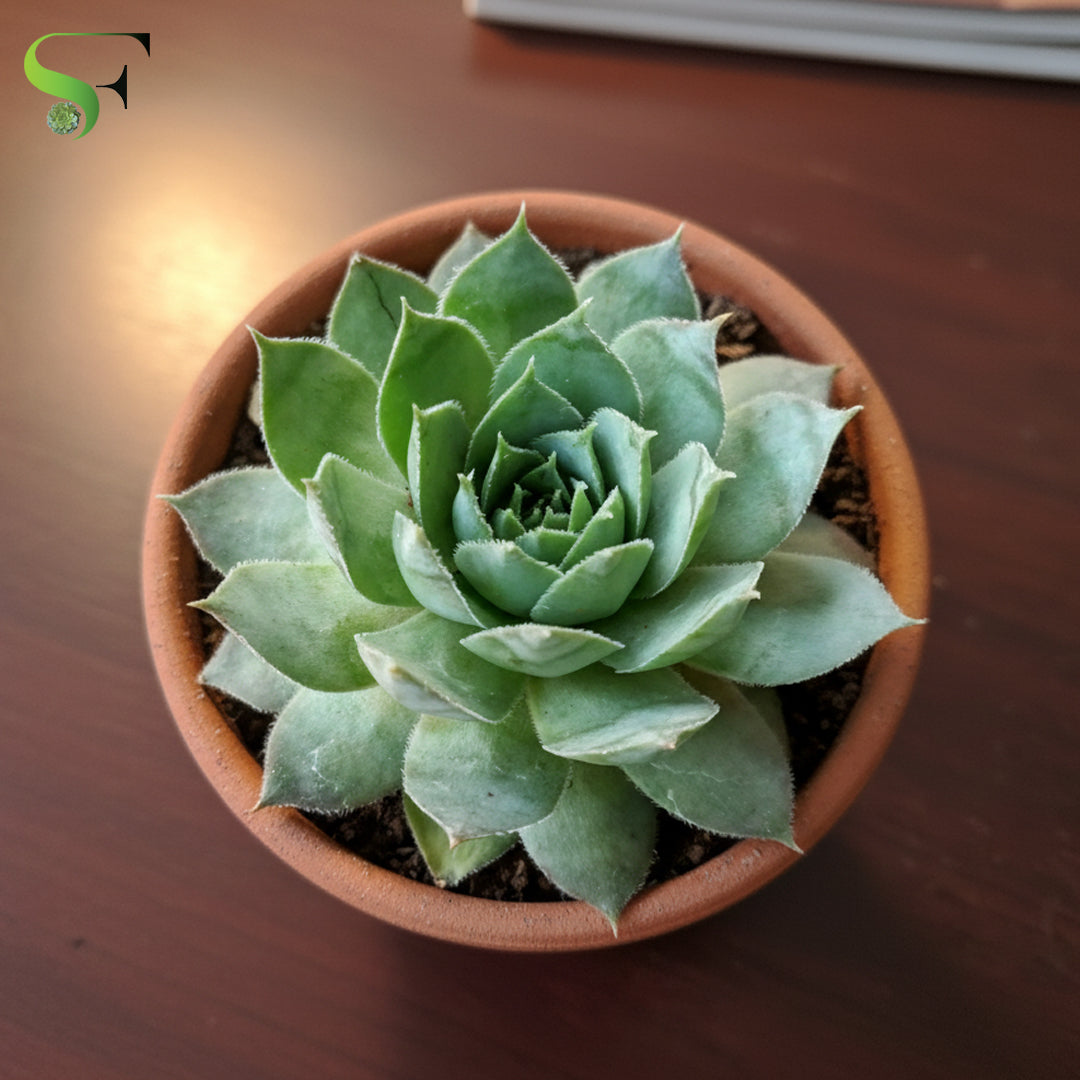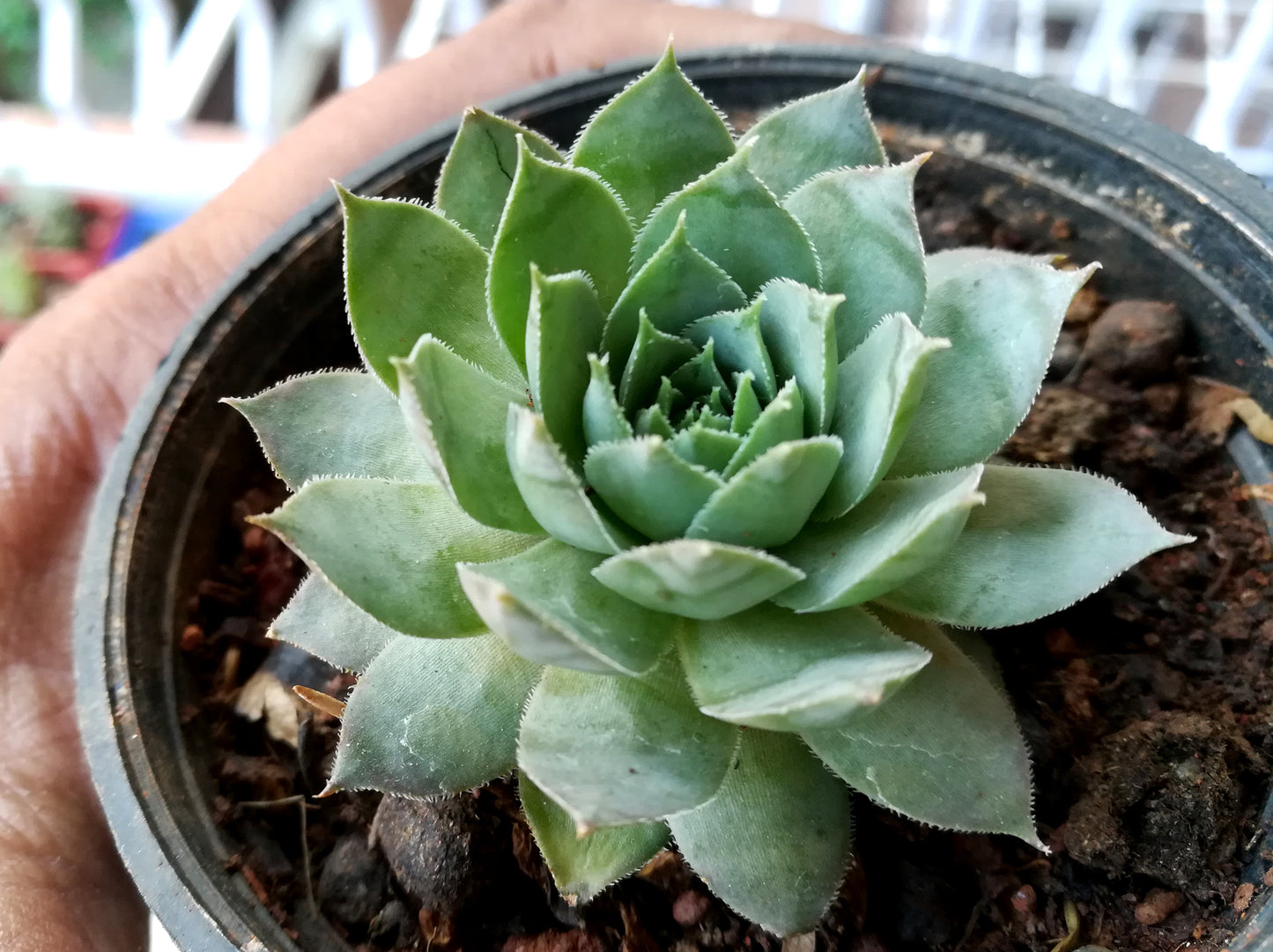Sempervivum - Lakshmi Kamal -Laxmi Kamal - H13
Sempervivum - Lakshmi Kamal -Laxmi Kamal - H13
Couldn't load pickup availability
ALL THE PLANTS WILL BE SENT BAREROOTED. NO POTS. NO SOIL
Sempervivum, commonly known as "Hens and Chicks" or "Houseleeks," are incredibly popular succulent plants known for their hardiness, diverse forms, and ease of care. Their name, "Sempervivum," is Latin for "always living," which refers to their ability to survive tough conditions and readily produce offsets (new plants).
Here's a detailed look at Sempervivum plants, along with care tips:
About Sempervivum Plants:
-
Appearance: Sempervivums form dense, geometric rosettes of fleshy leaves. These rosettes can vary greatly in size, from tiny miniatures to several inches across. The leaves come in a wide array of colors including green, red, purple, blue-green, and even nearly black, often with contrasting tips or margins. Some varieties, like 'Cobweb' (Sempervivum arachnoideum), have delicate, web-like hairs connecting the leaf tips.
-
"Hens and Chicks": This common name refers to their unique growth habit. The large, mature rosette is the "hen," and it produces numerous small offsets, or "chicks," around its base on horizontal stems (stolons). These chicks can be easily separated and planted to create new plants.
-
Monocarpic Nature: Each individual "hen" rosette is monocarpic, meaning it flowers once and then dies. However, before it dies, it produces plenty of "chicks" to ensure the plant's survival and spread. The flower stalk rises from the center of the rosette, bearing star-shaped flowers (usually pink, red, or yellow) in summer.
-
Hardiness: Sempervivums are remarkably hardy and drought-tolerant. They are native to the mountainous regions of southern Europe, North Africa, and western Asia, making them well-adapted to harsh conditions, including cold temperatures and poor soils. Many varieties are frost-hardy and can withstand freezing winters.
-
Uses: They are excellent for:
-
Rock gardens
-
Container plantings (especially shallow pots or troughs)
-
Crevices in walls or between stepping stones
- Green roofs
-
Edging or borders
- Small-area ground cover
-
Rock gardens
Sempervivum Care and Tips:
Sempervivums are low-maintenance plants that thrive on neglect. Here's how to keep them happy:
-
Light:
-
Full Sun is Best: Sempervivums thrive in full sun, meaning at least 6 hours of direct sunlight per day. This promotes the best foliage coloration and compact growth.
-
Partial Shade: They can tolerate some light shade, especially in extremely hot climates where afternoon shade can prevent leaf scorch. However, too much shade can lead to leggy, spindly growth and duller colors.
- Indoors: If growing indoors, place them in a window that receives as much bright, direct light as possible, ideally a south or east-facing window. Supplemental artificial lighting may be necessary.
-
Full Sun is Best: Sempervivums thrive in full sun, meaning at least 6 hours of direct sunlight per day. This promotes the best foliage coloration and compact growth.
-
Soil:
-
Excellent Drainage is Crucial: This is the most critical factor for Sempervivum health. They absolutely hate sitting in soggy soil, which leads to root rot.
- Gritty or Sandy Soil: Use a well-draining succulent or cactus potting mix. If using regular potting soil, amend it heavily with materials like perlite, coarse sand, pumice, or small gravel (25-50% grit).
-
Outdoor Planting: For outdoor beds, if your soil is heavy clay, work in plenty of grit or pea-sized gravel to improve drainage.
-
Excellent Drainage is Crucial: This is the most critical factor for Sempervivum health. They absolutely hate sitting in soggy soil, which leads to root rot.
-
Watering:
-
Drought Tolerant: Sempervivums are adapted to withstand drought and require very little water.
-
Allow Soil to Dry Completely: Water thoroughly, allowing the soil to dry out completely between waterings. One generous watering is better than frequent light waterings.
- Reduce in Winter: During their dormant period in autumn and winter, significantly reduce watering to about once a month, or even less.
-
Avoid Wetting Rosettes: When watering, try to avoid getting water directly on the rosettes, as this can lead to rot, especially in humid conditions. Bottom watering or a watering bottle can be helpful for potted plants.
-
Drought Tolerant: Sempervivums are adapted to withstand drought and require very little water.
-
Temperature and Humidity:
-
Wide Range of Temperatures: Sempervivums are incredibly tolerant of temperature fluctuations and are frost-hardy. Many varieties can survive temperatures as low as -20°C (-4°F).
-
Good Airflow: They appreciate good ventilation, especially if grown in protected environments like greenhouses, to prevent fungal diseases. Avoid overcrowding.
- Winter Protection: While hardy, a layer of straw can provide extra insulation for outdoor plants in extremely cold winters. If you have a non-hardy variety or live in an area with prolonged wet winters, consider moving potted plants indoors.
-
Wide Range of Temperatures: Sempervivums are incredibly tolerant of temperature fluctuations and are frost-hardy. Many varieties can survive temperatures as low as -20°C (-4°F).
-
Fertilizer:
-
Minimal Needs: Sempervivums generally do not require much fertilizer and can thrive in "poor" soils.
-
Light Feeding (Optional): If you wish to fertilize, do so sparingly in the spring at the start of their growing season. Use a diluted succulent fertilizer or a slow-release granular fertilizer, low in nitrogen.
-
Minimal Needs: Sempervivums generally do not require much fertilizer and can thrive in "poor" soils.
-
Potting and Repotting:
- Drainage Holes are a Must: Always use pots with drainage holes. Terracotta pots are excellent as they allow for better airflow and evaporation.
-
Shallow Root System: Their shallow root system makes them suitable for small pots, shallow bowls, or even quirky containers like old shoes or teacups, as long as drainage is provided.
-
Repotting: Repot every one to two years during the growing season (spring/summer) into a pot that is slightly larger (about 10% larger) if needed.
-
Propagation:
- Offsets (Chicks): The easiest and most common way to propagate Sempervivums is by separating the "chicks" from the "hen." Simply snip the stolon connecting the chick to the mother plant and plant the chick in well-draining soil. They will root readily.
- Seeds: While possible, growing from seed is more challenging, and the resulting plants may not be true to the parent variety due to easy hybridization.
-
Pests and Diseases:
-
Generally Resistant: Sempervivums are quite resistant to pests and diseases when grown in proper conditions.
- Overwatering Issues: The biggest problem is often overwatering, which leads to crown rot or root rot. Ensure proper drainage and allow the soil to dry out.
-
Occasional Pests: Mealybugs or aphids can sometimes be an issue, particularly on indoor plants. Treat with insecticidal soap if needed.
-
Generally Resistant: Sempervivums are quite resistant to pests and diseases when grown in proper conditions.
Key Takeaways for Success:
- Drainage, Drainage, Drainage! This cannot be stressed enough.
- Plenty of Sunlight.
- Err on the side of underwatering.
- Don't over-fertilize.
-
Embrace their "hens and chicks" growth habit for easy propagation.
With their striking rosettes, varying colors, and minimal demands, Sempervivums are a fantastic choice for both novice and experienced gardeners looking for a hardy and beautiful succulent.
Share




